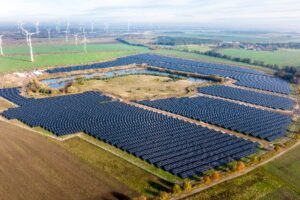What is the Environmental Impact of Wave Energy?

In the quest for sustainable energy sources, wave energy has emerged as a promising candidate. This form of energy harnesses the power of ocean waves to generate clean electricity. While it offers a greener alternative to fossil fuels, understanding its environmental impact is crucial for its integration into the global energy mix. This article explains what is the environmental impact of wave energy.
The Basics of Wave Energy
Wave energy converts the kinetic and potential energy in ocean waves into electricity. Devices like point absorbers, attenuators, and oscillating water columns are deployed in the sea to capture this energy. These technologies vary in design, but their goal is uniform: to tap into the vast, renewable power of the seas.
Positive Environmental Impacts
Low Carbon Footprint
The most significant environmental benefit of wave energy is its minimal greenhouse gas emissions. Unlike fossil fuels, wave energy doesn’t release carbon dioxide or other harmful pollutants during operation, making it a clean energy source.
Renewable and Sustainable
Wave energy is a renewable resource, constantly replenished by the wind and the sun. It’s an inexhaustible source of energy, in stark contrast to finite fossil fuels.
Reduced Dependence on Fossil Fuels
By supplementing the energy mix, wave energy can reduce our reliance on fossil fuels, thereby helping to mitigate climate change and air pollution.
Potential Environmental Concerns
While wave energy is environmentally friendly, certain concerns need to be addressed:
Marine Ecosystems
The installation of wave energy devices can potentially disrupt marine ecosystems. The anchoring of these structures might alter seabed environments, and their presence could affect the natural behavior and migration patterns of marine life.
Noise Pollution
Underwater noise produced by wave energy devices can impact marine species, particularly those reliant on sonar navigation like dolphins and whales.
Visual Impact and Navigation
Wave energy installations may have a visual impact on coastal landscapes. They might also interfere with marine navigation, affecting shipping routes and fishing areas.
Maintenance and Durability
The marine environment is harsh, with saltwater corrosion and storm damage posing significant challenges. The environmental cost of maintaining and repairing wave energy infrastructure is a concern, especially if it involves frequent interventions and replacements.
Mitigating the Environmental Impact
To harness wave energy sustainably, proactive measures are essential:
Environmental Assessments
Comprehensive environmental impact assessments should be conducted before installing wave energy devices. These studies help in understanding and mitigating potential impacts on marine ecosystems.
Eco-Friendly Design and Placement
Wave energy devices must be designed with minimal environmental disruption in mind. Careful selection of locations, away from sensitive marine habitats and migratory paths, is crucial.
Technological Innovations
Continued research and development can lead to more efficient and less intrusive wave energy technologies. Advances in materials science, for instance, can yield more durable and less environmentally damaging components.
Monitoring and Regulation
Ongoing monitoring of wave energy projects can help in promptly identifying and addressing environmental issues. Regulatory frameworks should ensure that wave energy developments do not compromise marine health.
Measures to reduce the impact of wave energy impact on the environment
Integration with Existing Marine Activities
A critical aspect of wave energy’s environmental impact is how it integrates with existing marine activities. The ocean is a vast resource used for various purposes, including fishing, shipping, tourism, and recreation. The placement of wave energy devices should be strategically coordinated to minimize conflicts with these existing uses. This involves identifying areas that are not critical to marine navigation, commercial fishing grounds, or popular recreational sites. Such thoughtful placement not only reduces environmental impact but also helps in garnering public and stakeholder support.
Contribution to Coastal Protection
An often overlooked benefit of wave energy installations is their potential contribution to coastal protection. Wave energy devices can act as artificial breakwaters, reducing coastal erosion. By absorbing wave energy, they can mitigate the impact of storm surges and protect shorelines, which is increasingly important in the face of rising sea levels and more frequent extreme weather events due to climate change.
Biodiversity and Habitat Creation
Interestingly, wave energy installations can have a positive impact on local marine biodiversity. Similar to artificial reefs, these structures can provide new habitats for marine organisms. They can become colonization sites for a variety of marine species, potentially increasing local biodiversity. However, this aspect requires careful monitoring to ensure that such habitats do not disturb the existing ecological balance or encourage invasive species.
Energy Security and Local Communities
The deployment of wave energy has implications for energy security, particularly for remote coastal and island communities. In many isolated areas, energy is often sourced from diesel generators, which are not only expensive but also environmentally damaging. Wave energy can provide a more sustainable and potentially cheaper alternative, reducing the carbon footprint of these communities and improving their energy security.
The Road Ahead
As the technology matures, the scalability of wave energy becomes a significant consideration. The ability to deploy wave energy on a large scale without causing substantial environmental disturbance is key to its success as a sustainable energy source. This calls for not just technological advancements but also collaboration between governments, environmental organizations, and industry players to create guidelines and best practices for wave energy development.

The kinetic energy of waves is converted into clean power today, image source: Unsplash
Education and Public Engagement
Public awareness and education about wave energy’s benefits and impacts are essential. Misconceptions and lack of understanding about this emerging technology can hinder its acceptance and development. Engaging with the public, policymakers, and environmental groups transparently can help in building trust and support for wave energy projects.
Policy and Regulatory Frameworks
Effective policy and regulatory frameworks are crucial in shaping the sustainable development of wave energy. These policies need to balance the promotion of renewable energy with the protection of marine environments. Incentives for clean energy technologies, coupled with stringent environmental regulations, can guide the responsible development of wave energy.

We have to use waves as a clean source of power without affecting marine life, image source: Unsplash
The Role of Wave Energy in the Future Energy Landscape
As we move towards a more sustainable future, the role of wave energy cannot be understated. Its potential to provide a significant portion of our energy needs while maintaining a low environmental impact is promising. However, the success of wave energy depends on balancing energy production with environmental stewardship.
Conclusion
Wave energy presents a compelling case as a clean, renewable energy source. Its low carbon footprint and sustainability are major assets in the fight against climate change. However, its development must be approached with an acute awareness of its potential environmental impacts. With careful planning, technological advancements, and regulatory oversight, wave energy can be a key player in the global shift towards renewable energy sources, harmoniously coexisting with the natural marine environment.







